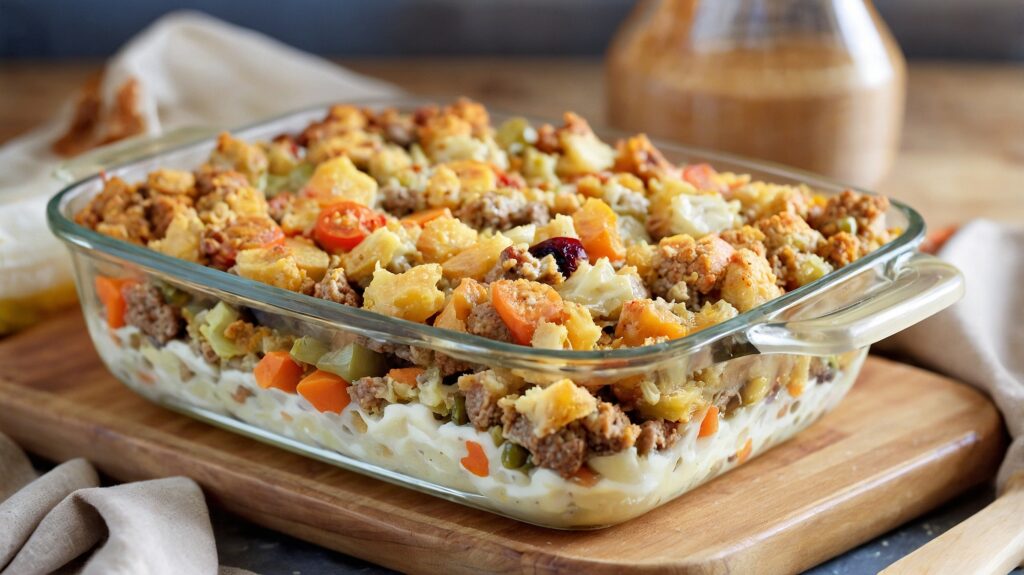This irresistible Stuffing Casserole offers a unique twist on traditional stuffing, merging the familiar comfort of its flavors with the satisfying texture of a casserole.
With a harmonious blend of ingredients such as ground sausage, fresh vegetables, and a creamy base, this dish not only serves as a comforting meal but also presents an opportunity for culinary creativity.
As we explore the essential components and preparation techniques, one must consider how this dish can be adapted to suit various tastes and occasions, revealing a surprising versatility that merits further examination.
Stuffing Casserole Overview
Stuffing Casserole is a delectable dish that marries the comforting flavors of traditional stuffing with a hearty casserole format, making it an ideal accompaniment to roast chicken.
Rooted in stuffing history, this innovative dish reimagines the classic preparation by combining the elements into a seamless, flavorful experience.
The origins of casseroles date back to the 18th century in France, when they were used to create one-dish meals that consolidated ingredients for ease of cooking and serving.
In this modern twist, the dish offers a convenient and satisfying option, perfect for gatherings or family dinners.
With its rich flavors and versatility, Stuffing Casserole elevates the dining experience while honoring its culinary heritage.

Key Ingredients
A delightful array of ingredients comes together to create the rich and satisfying flavors of the Stuffing Casserole.
Ground sausage, available in sweet, hot, or breakfast varieties, serves as the flavorful backbone, while fresh or frozen green beans, onions, celery, and minced garlic infuse the dish with vibrant freshness.
Utilizing low-sodium chicken broth and a creamy base of condensed cream of chicken soup and sour cream not only enhances texture but also contributes valuable health benefits.
The boxed stuffing provides convenience and can be personalized with flavor variations, such as herbs or spices.
Topped with crispy fried onions, this casserole promises an irresistible balance of taste and texture, making it a standout addition to any meal.
Step-by-Step Preparation
Typically, preparing the Stuffing Casserole involves a straightforward yet rewarding process that brings together a medley of flavors and textures.
Begin by browning your choice of ground sausage in a skillet, utilizing the cooking technique of sautéing to enhance its rich flavor.
Set the sausage aside, then sauté butter, celery, and onions until they soften, followed by a minute of cooking with minced garlic, salt, and pepper for additional flavor enhancements.
Combine this mixture with chicken broth, cream of chicken soup, and sour cream for a creamy base. Fold in the stuffing and sausage, then transfer to a greased casserole dish.
Make-Ahead Tips
Preparing the Stuffing Casserole in advance can save both time and effort on busy days, making it a convenient option for gatherings or family dinners.
To streamline your preparation timeline, assemble the casserole up to three days prior, ensuring all ingredients are well mixed and stored in the refrigerator. This allows the flavors to meld beautifully.
For those looking to customize, consider ingredient substitutions such as swapping the ground sausage for turkey sausage or using vegetable broth instead of chicken for a lighter option.
Remember to let the casserole sit at room temperature for 10-15 minutes before baking, ensuring even cooking.
Embracing these make-ahead tips guarantees a delightful dish, ready to impress your guests with minimal last-minute fuss.
Storage Suggestions
Proper storage of the Stuffing Casserole is essential to maintain its flavor and texture, ensuring it remains a delightful addition to your meals.
To enjoy this innovative dish at its best, consider the following storage suggestions:
- Refrigeration: Store leftovers in an airtight container for up to three days. Allow the casserole to cool completely before sealing.
- Freezing: For longer preservation, freeze portions in individual containers for up to three months. This aids in portion control and convenience.
- Reheating Tips: When ready to enjoy, thaw overnight in the refrigerator and reheat in the oven at 350°F until warmed through, ensuring the casserole retains its delectable taste and texture.
Cooking Methods
After ensuring ideal storage practices for your Stuffing Casserole, understanding the various cooking methods available can enhance your experience with this versatile dish.
The Crock Pot method offers a hands-off approach; simply brown the sausage, combine it with your uncooked ingredients, and let it cook on low for 6-7 hours or high for 4 hours.
For a crisp topping, finish in a 350°F oven for 10 minutes, adding crispy fried onions for the final 5 minutes.
Alternatively, oven baking provides a more traditional route: bake covered for 1 hour, then uncover for an additional 5 minutes.
Whichever method you choose, both promise a delightful medley of flavors and textures that will elevate your meal.
Serving Ideas
When it comes to serving your Stuffing Casserole, consider pairing it with a variety of accompaniments that will enhance its rich flavors and textures.
The ideal serving temperature for this dish is warm, allowing the creamy and savory notes to shine through.
To elevate the dining experience, explore these innovative pairing suggestions:
- Roasted Brussels sprouts: Their crispy edges and nutty flavor complement the casserole beautifully.
- Cranberry sauce: A dollop of tangy sweetness adds a revitalizing contrast to the savory elements.
- Herbed turkey slices: This classic pairing brings a festive touch, perfect for holiday gatherings.
Variations and Additions
Exploring variations and additions to the Stuffing Casserole can elevate this dish to new culinary heights, catering to diverse tastes and preferences.
Consider incorporating herb variations such as fresh thyme, rosemary, or sage to infuse aromatic depth. For protein alternatives, diced rotisserie chicken or vegetarian sausage can add unique textures and flavors, appealing to a wider audience.
Veggie additions like sautéed mushrooms, bell peppers, or spinach not only enhance nutrition but also contribute vibrant colors and tastes.
Finally, flavor enhancements such as a splash of white wine or a sprinkle of nutmeg can transform the casserole into an extraordinary dish.
Embracing these innovative tweaks guarantees a delightful experience for every palate at the table.

